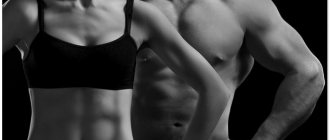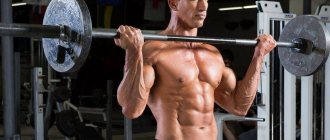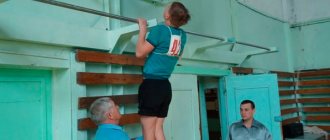How it works?
Have you seen photos of sprinters? Compare them to marathon or middle-distance runners. As a rule, sprinters are muscular guys, while middle and long distance runners are ordinary pimps.
The fact is that muscle mass is a consequence of anaerobic training. This is strength training, while running for a long time is an aerobic exercise.
Sprinting is a strength exercise. This does not fit into the minds of most beginner athletes who are accustomed to the fact that running does not grow muscles.
Sprinting promotes muscle gain due to the following features:
- Increasing testosterone levels . Scientists have found: regular practice of acceleration helps increase testosterone production by 20-30%;
- Pumping up the muscles of the legs and buttocks . Apparently, the increase in the level of the main anabolic hormone, without which gaining muscle mass is impossible, is due to the fact that during sprints literally all the muscles are worked out. But the emphasis is on the actively working muscles of the lower body. The legs and buttocks are the largest muscle group. And the larger the group, the more significant the effect on the release of testosterone. Plus, sprints are a great way to work your legs and glutes without the heavy lifting. For better effect, you can do jerks uphill, uphill;
- Improving blood circulation, training the cardiovascular system . Sprinting in the fresh air contributes to the overall health of the body. A huge amount of oxygen is pumped through the body, which helps improve the functioning of all body systems and the influx of positive thoughts into the head;
- There is a flow of blood to the pelvic organs . Sprinting is an opportunity to improve bed life for both men and women :)
Running and hormonal levels
In response to jogging, the body increases the production of certain hormones involved in the restoration and regulation of the nervous, cardiovascular, reproductive and other systems. Some of them have an effect on the restoration and construction of new muscle tissue.
Somatotropin
Or growth hormone. With age, its production in the body decreases as unnecessary. But in an athlete’s body it is still necessary for the construction of new tissues: with its help, insulin synthesizes protein. Or it doesn’t synthesize – this is how fat deposits appear from calories. The hormone is produced approximately 10 minutes after the start of training, but ceases to be synthesized when the body gets used to the same loads. Therefore, it makes sense to change exercises and types of training.
Testosterone
Reduces the time the body needs to recover, stimulates endurance and metabolic rate. That same “second wind”. And, contrary to popular belief, it doesn't just work for men. Testosterone is produced when running short distances at maximum speed or alternating “sprint” runs and a comfortable pace. It is synthesized most actively in the morning hours - for example, during a morning jog.
Insulin
A hormone produced by the pancreas primarily for the absorption of glucose. The main association with healthy insulin levels is a healthy metabolism. Participates in the distribution of load (including sports) on the endocrine system; with the duration of training, its concentration decreases. So a short but intense run will also contribute to insulin production.
Thyroxine
Produced by the thyroid gland, it is converted in the body and becomes the T4 hormone. With additional synthesis or “release” of this hormone, the body spends more calories, but due to them it ensures the active maintenance of muscle (tone) and brain function. Active training can increase the production of thyroxine by a third, and its elevated level will remain in the blood for several hours after training.
Sprinting for muscle growth. Rules
Adhere to the following rules to build a correct training system:
- Start accelerating gradually . Speed running is more exhausting than regular running. Start smoothly, no hour-long sprint training from the first classes. More detailed information can be obtained in the material on the principle of load progression, and the article on supercompensation;
- Avoid eating 2 hours before running . During intense work, food may come back;
- In hot weather, try to find shade, or run at a comfortable time of day . The best option is early morning or late evening;
- Choose comfortable shoes and clothes . If the equipment is uncomfortable, an increased amount of cortisol will be released during exercise. Cortisol is a stress hormone that perpetuates negative actions. At the unconscious level, the attitude “Running is stress” will appear. This is clearly not what we need;
- Strengthen sprinting for muscle growth with pleasure hormones . Refrain from listening to music for 2-3 days. For your first workout, take headphones and listen to your favorite songs. During this process, happiness hormones will be released, which will reinforce running as a pleasant and useful activity;
Nutrition for runners
Working out in the morning on an empty stomach is not a good idea. During night sleep, glycogen reserves in the liver are consumed, participating in maintaining uniform glucose levels. This function is further carried out by muscle glycogen. It will also be used up during your morning jog. And in order for fat to begin to be burned, carbohydrates are needed. Because without the presence of carbohydrates, fat breakdown is impossible. So say biochemists.
For effective running training and achieving the desired results, proper nutrition is the key to success, and you also need to know your own basal metabolic rate . Only after this should you start planning your diet. The table shows the values of the level of basal metabolism, expressed in calories, taking into account the gender, age and body weight of the runner.
Basal metabolic rate
| men | women | ||||||||
| Body mass | 18-29 years old | 30-39 years old | 40-59 years old | Over 60 years old | Body mass | 18-29 years old | 30-39 years old | 40-59 years old | Over 60 years old |
| 50 kg | 1450 | 1370 | 1280 | 1180 | 40 kg | 1080 | 1050 | 1020 | 960 |
| 55 kg | 1520 | 1430 | 1350 | 1240 | 45 kg | 1150 | 1120 | 1080 | 1030 |
| 60 kg | 1590 | 1500 | 1410 | 1300 | 50 kg | 1230 | 1190 | 1160 | 1100 |
| 65 kg | 1670 | 1570 | 1480 | 1360 | 55 kg | 1300 | 1260 | 1220 | 1160 |
| 70 kg | 1750 | 1650 | 1550 | 1430 | 60 kg | 1380 | 1340 | 1300 | 1230 |
| 75 kg | 1830 | 1720 | 1620 | 1500 | 65 kg | 1450 | 1410 | 1370 | 1290 |
| 80 kg | 1920 | 1870 | 1700 | 1570 | 70 kg | 1530 | 1490 | 1440 | 1360 |
| 85 kg | 2010 | 1900 | 1780 | 1640 | 75 kg | 1600 | 1550 | 1510 | 1430 |
| 90 kg | 2110 | 1990 | 1870 | 1720 | 80 kg | 1680 | 1630 | 1580 | 1500 |
We find the daily energy consumption by multiplying the found values from two tables.
Physical activity rate
| 1. Knowledge workers. Performing work that does not require physical effort (doctors, teachers, dispatchers, secretaries, office workers) | 1,4 |
| 2. Light physical labor workers (nurses, hairdressers, etc.) | 1,6 |
| 3. Workers of moderate labor (salespeople, transport drivers, surgeons) | 1,9 |
| 4. Heavy physical labor workers (construction workers, gas and oil industry workers) | 2,2 |
| 5. Workers of very heavy physical labor (miners, steelworkers, masons, loaders) | 2,5 |
Example: A 40-year-old man, weight 80 kg, works as a surgeon.
From the first table - the level of basal metabolism is 1700 cal/day.
From the second table - physical activity coefficient 1.9
Daily energy consumption = 1700 cal/day×1.9 = 3230 cal/day
This means that this man, going about his daily business, spends 3230 calories per day.
This means that he must replenish his energy reserves to this level.
Now you have the treasured figure from which you will build when compiling your food diary.
The caloric content of your diet will depend on the regularity of your running training.
On days free from training, the BJU ratio is:
Proteins 20%
Fat 30%
Carbohydrates 50%
On training days, this ratio changes to provide the body with the necessary nutrients:
Proteins 30% - Content increases to 1.5 g/kg body weight to the detriment of fats.
Fats 20%
Carbohydrates 50%
Before running
For an effective workout, proper nutrition is necessary; the amount of food will depend on the time you start physical activity.
If there is enough time before training, for example 2-3 hours, then the serving size should be nutritious - 300-400 calories . In addition to proteins and complex carbohydrates, we add a minimum amount of fat in the form of vegetable oils and nuts, and do not forget about vegetables and fruits. Large meals and fatty foods should be avoided - this can lead to nausea, vomiting and abdominal discomfort.
Instead of a heavy meal, you can drink a protein shake.
If the workout begins in an hour or less, then the body must be supplied with carbohydrates.
Protein bars, dried fruits, muesli, nuts, and natural yogurt are suitable as energy drinks.
Half an hour before your run, you can drink a glass of liquid. Excess water will strain the kidneys and liver. While running, you should drink a couple of sips every couple of kilometers.
After running
To maintain muscle mass, you should eat within 1 hour after training. The choice must be made in favor of proteins and complex carbohydrates - on the basis of: for every 100 grams of carbohydrates, 7-9 grams of protein. If a full meal is not possible, then you can snack on fruit. Or replace a meal with a protein shake.
Bonus in the form of the sea
Athletes who live close to the sea are in luck: you can use sprinting to grow muscles as part of your health system. In the summer we run directly along the shore, in other seasons we run near it. Sea air helps to significantly improve the functioning of all body systems. The sea protects against most diseases, improves skin condition, improves mood, and relieves psychological stress.
Running near the sea is perhaps the most useful thing that humanity has in its arsenal now. Plus, it's free. So if you are lucky enough to be among the lucky ones living near the sea, take advantage of this opportunity.
Training programs
A standard sprint training program looks like this:
| Distance in meters | Approaches | Rest after approach in minutes | Rest after the distance in minutes |
| 5 minutes at an easy pace | 1 | — | 2 |
| 100 | 5 | 1,5 | 3 |
| 200 | 3 | 2 | 3 |
| 400 | 2 | 3 | 3 |
| 100 | 3 | 1,5 | 1,5 |
| 10 minutes at an easy pace | 1 | — | — |
But we are starting gradually. Sprinting for muscle growth in a step-by-step mode may look like this:
Program No. 1
| Distance in meters | Approaches | Rest after approach in minutes | Rest after the distance in minutes |
| 5 minutes at an easy pace | 1 | — | 2 |
| 100 | 3 | 1,5 | — |
Program No. 2
| Distance in meters | Approaches | Rest after approach in minutes | Rest after the distance in minutes |
| 5 minutes at an easy pace | 1 | — | 2 |
| 100 | 5 | 1,5 | — |
Program No. 3
| Distance in meters | Approaches | Rest after approach in minutes | Rest after the distance in minutes |
| 5 minutes at an easy pace | 1 | — | 2 |
| 100 | 5 | 1,5 | 3 |
| 200 | 2 | 2 | — |
Program No. 4
| Distance in meters | Approaches | Rest after approach in minutes | Rest after the distance in minutes |
| 5 minutes at an easy pace | 1 | — | 2 |
| 100 | 5 | 1,5 | 3 |
| 200 | 3 | 2 | — |
Program No. 5
| Distance in meters | Approaches | Rest after approach in minutes | Rest after the distance in minutes |
| 5 minutes at an easy pace | 1 | — | 2 |
| 100 | 5 | 1,5 | 3 |
| 200 | 3 | 2 | 3 |
| 400 | 1 | — | — |
Workout #6
| Distance in meters | Approaches | Rest after approach in minutes | Rest after the distance in minutes |
| 5 minutes at an easy pace | 1 | — | 2 |
| 100 | 5 | 1,5 | 3 |
| 200 | 3 | 2 | 3 |
| 400 | 2 | 3 | — |
Workout #7
| Distance in meters | Approaches | Rest after approach in minutes | Rest after the distance in minutes |
| 5 minutes at an easy pace | 1 | — | 2 |
| 100 | 5 | 1,5 | 3 |
| 200 | 3 | 2 | 3 |
| 400 | 2 | 3 | 3 |
| 100 | 1 | — | — |
Workout #8
| Distance in meters | Approaches | Rest after approach in minutes | Rest after the distance in minutes |
| 5 minutes at an easy pace | 1 | — | 2 |
| 100 | 5 | 1,5 | 3 |
| 200 | 3 | 2 | 3 |
| 400 | 2 | 3 | 3 |
| 100 | 2 | 1,5 | — |
Program No. 9
| Distance in meters | Approaches | Rest after approach in minutes | Rest after the distance in minutes |
| 5 minutes at an easy pace | 1 | — | 2 |
| 100 | 5 | 1,5 | 3 |
| 200 | 3 | 2 | 3 |
| 400 | 2 | 3 | 3 |
| 100 | 3 | 1,5 | 1,5 |
Program No. 10
| Distance in meters | Approaches | Rest after approach in minutes | Rest after the distance in minutes |
| 5 minutes at an easy pace | 1 | — | 2 |
| 100 | 5 | 1,5 | 3 |
| 200 | 3 | 2 | 3 |
| 400 | 2 | 3 | 3 |
| 100 | 3 | 1,5 | 1,5 |
| 10 minutes at an easy pace | 1 | — | — |
We are arriving at this program gradually. Only with smooth progress will sprinting allow you to gain muscle mass.
Have you used sprinting to grow muscles? Share your experience in the comments!
Share link:
- Click to share on Twitter (Opens in new window)
- Click here to share content on Facebook. (Opens in a new window)
Running and terrain
Even following a high-protein diet, an athlete is forced to create a calorie surplus while gaining weight, otherwise no gain will occur. Despite the fact that the goal is “lean” body weight, and the training plan is scheduled for every day, the body will stubbornly accumulate fat deposits, albeit small ones. A minimal layer of fat is necessary for the normal functioning of the endocrine system and metabolism, so you should not try to completely get rid of it. But in most cases, the percentage of body fat is far from minimal.
Therefore, running is a tool that can “demonstrate” the desired results and make the figure visually more athletic. Even taking into account the fact that calorie consumption will increase, and some part of the muscle mass may be lost, the figure will look more athletic and harmonious. Against the background of a reduced percentage of fat, muscle mass will become more noticeable - especially since running also develops general endurance, which can be used in the next strength training.
That is, first of all, running actually increases the total calorie consumption and does not contribute to the accumulation of mass, but secondly, it makes progress in mass gain more accessible in the future: by increasing endurance and the external visibility of the result.











